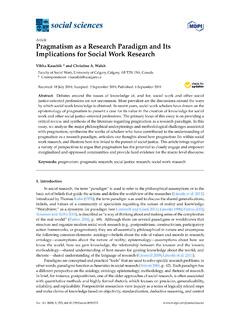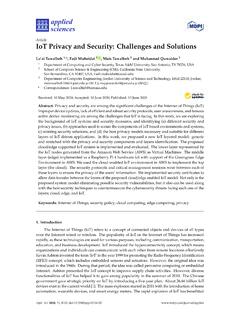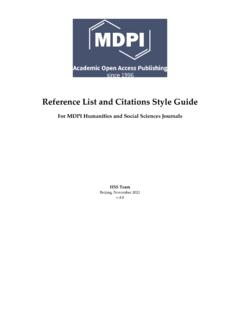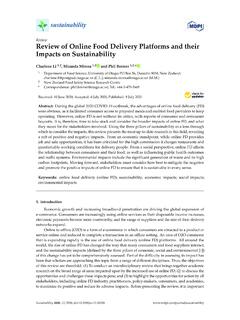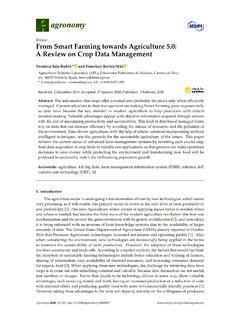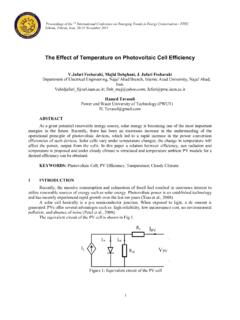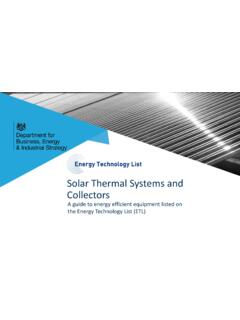Transcription of Study of Heat Transfer and the Hydrodynamic Performance …
1 Article Study of Heat Transfer and the Hydrodynamic Performance of Gas Solid Heat Transfer in a Vertical Sinter Cooling Bed Using the CFD-Taguchi-Grey Relational Analysis Method Junpeng Fu * and Jiuju Cai Department of Thermal Engineering, SEP Key Laboratory of Eco-Industry, School of Metallurgy, Northeastern University, Shenyang 110819, China; * Correspondence: Received: 4 April 2020; Accepted: 24 April 2020; Published: 2 May 2020. Abstract: The vertical sinter cooling bed (VSCB) is a high-efficiency energy-saving and environmentally friendly waste heat recovery equipment. In this Study , a computational fluid dynamics (CFD). convection model was established to reveal the typical factors on the thermodynamic Performance in VSCB. Indeed, a multiple Performance optimal algorithm based on the Taguchi-grey relational analysis (GRA) method was first applied to investigate the effects of geometric and operational factors, including the diameter of the bed, height of the bed, air mass flow rate, air inlet temperature, and sinter mass flow rate, on improving the heat Transfer (Ex) and Hydrodynamic Performance (Pdrop) and obtain the optimum combination of each factor in VSCB.
2 The results found that the diameter of the bed was the most influential factor contributing the multiple types of Performance with a contribution rate of , followed by the air mass flow rate ( ), while the height of the bed ( ) exerted a limited effect on the Performance of multiple processes. The optimal combination of factors (A1B5C5D5E1) was compared with the initially selected parameters by performing a confirmation test. The performances of heat Transfer and hydrodynamics were improved by the Taguchi with the GRA. method. Keywords: vertical bed; computational fluid dynamic; grey relational analysis; Taguchi method 1. Introduction The vertical cooling bed is widely used in various industries, such as the metallurgical [1], energy [2], chemical [3], and food [4] sectors. In particular, the steel industry accounts for of the energy consumption by the entire industrial sector, which is deemed a process with extensive energy consumption and emission production [5].
3 Several types of vertical cooling packed beds have been employed in different processes during steel production, such as a slag furnace, vertical pellet furnace, coke dry quench, and sinter vertical packed bed. According to the published literature [6], the energy consumed by the sintering process accounts for 15% of the total energy consumption of the steel industry. Therefore, studies designed to improve the efficient utilization and recovery of waste heat resources from the sintering process are very important. Furthermore, researchers have focused on developing several methods to reduce energy consumption and increase the efficiency of utilization of available recovered energy waste [6 8]. In general, the circular and linear moving sinter cooling beds use gas leakage with low efficiency. The novelty vertical sinter cooling packed bed was invented for the efficient recovery and utilization of waste heat from the sinter cooling process.
4 Although previous studies have focused on the design parameters, the most effective factor and the contribution rate of the factor to the thermodynamic characteristics have not been investigated using a systematic statistical method. In this Study , the investigation of the heat Transfer Performance of Energies 2020, 13, 2225; Energies 2020, 13, 2225 2 of 30. vertical sinter cooling bed was the objective function, and the effects of five design factors were investigated with the help of a three-dimensional computational fluid dynamics (CFD)-simulated model. In addition, The Taguchi-grey relational analysis method was used to determine the optimum combination of design factors, simultaneously impacting multiple target functions. Therefore, the aim of this Study was to determine the optimal combination of multiple Performance characteristics for simultaneously increasing the exergy of the air outlet and reducing the pressure drop in the vertical bed.
5 Vertical Sinter Cooling Bed (VSCB). This technical innovation creates a variation in the heat Transfer mechanism that transfers cross- flow heat transmission in a circular cooler to counter contact current heat Transfer in the VSCB. As shown in Figure 1, the sinter cooling process is operating in the cooling section, where heat Transfer is initiated between hot sinter particles and ambient temperature air with direct counter-current contact modes. The blazing sinter block is initially filled in the pre-store chamber that guarantees continuous sinter granular charging and then packed into the cooling section; the air is simultaneously introduced from the center and circular channels and flows through center air cowl into the cooling section. The cooled sinter granule is unloaded using a discharge device at the bottom of the vertical bed and heated air flows through a ramp channel and is recovered at the outlet of the VSCB.
6 The discharge device is composed of an electromagnetic vibrator and rotary sealing valve, ensuring the continuous and smooth discharge of sinter granules at a constant mass flow rate. As described above, the heat Transfer process between sinter granular and air occurs in a confined space (cooling section), which contributes to improving the heat Transfer efficiency and reducing air leakage. Figure 1. Schematic showing the operation of a vertical sinter cooling bed. Studies of the Heat Transfer Performance of the VSCB. In the past decade, many investigations aiming to improve heat Transfer Performance in terms of the exergy and energy have been performed. In general, theoretical, experimental, and simulated methods have been applied to improve the heat Transfer Performance of the VSCB. The published studies have mainly examined the effect of geometric and operating parameters on the heat Transfer process in the VSCB.
7 Feng et al. [9] presented the effects of the air inlet temperature and mass flow rate on the recovered exergy Performance based on a three-dimensional simulated model. Zheng et al. [10,11] presented the effects of several design parameters on the volumetric exergy Transfer Energies 2020, 13, 2225 3 of 30. coefficient and volumetric Transfer coefficient in terms of the second law of thermodynamics and pilot experimental method. Pan et al. [12] established a theoretical model of gas solid heat exchange to determine the effects of the operational parameters on the heat Transfer and pressure drop. Feng et al. [13] determined the overall heat Transfer coefficient using a pilot experimental method. In addition, experimental research has been conducted, and the reliability of the Nusselt number has been obtained from regression analysis and verification.
8 Zhang et al. [14] investigated the effects of structural and operating parameters on the exergy Performance of waste heat recovery using a 3D. calculated model. Four main parameters were studied in terms of exergy and energy consumption. Feng et al. [15] described the sinter bed system used to obtain the optimal combination of design parameters with the help of an orthogonal experiment to improve the heat Transfer Performance based on a 3D porous medium and non-equilibrium heat exchange model. Pan et al. [16] studied the volumetric heat Transfer coefficient and air pressure drop of a sinter layer based on the experimental method. The research on the vertical sinter cooling bed also examined the Hydrodynamic Performance , such as the pressure drop and energy loss, which are deemed as functions with a negative effect on the effectiveness of the heat resource recovery process.
9 Feng et al. [17] investigated the airflow pattern and pressure drop characteristics using an experimental approach. The flow regimes in the sinter bed were also partitioned into several parts in terms of the critical Reynolds number. The relationship between the pressure drop and the parameters of interest were established simultaneously. Tian et al. [18] studied the air pressure drop through a random distribution sinter packed bed by varying the irregular particle sizes, the porosity of the sinter layer, and sphericity for different flow regimes. The aforementioned studies, examining the heat Transfer Performance in a vertical sinter cooling bed, have mainly determined the effects of structural and operational parameters on the energy and exergy Performance , which is beneficial for providing comprehensive insights into the heat Transfer characteristics in a vertical sinter bed.
10 However, few studies have employed a systematic analytical approach with a statistical analysis of factors of interest that affect the heat Transfer Performance of the vertical sinter cooling bed along with a simultaneous assessment of multiple purpose functions. To our knowledge, the Taguchi with grey relational analysis (GRA) was established to analyze the effective parameters that affect multiple purpose functions and is necessary to obtain the relationship of the simulated and ideal results in the different design combinations. Studies of the Statistical Analysis Method The Taguchi grey relational analysis is a versatile technique that has been applied in various fields, such as iron and steel [19,20], heat exchanger [21], energy systems [22], refrigeration [23], powder metallurgy [24], building material [25], and chemical mechanical planarization [26].
